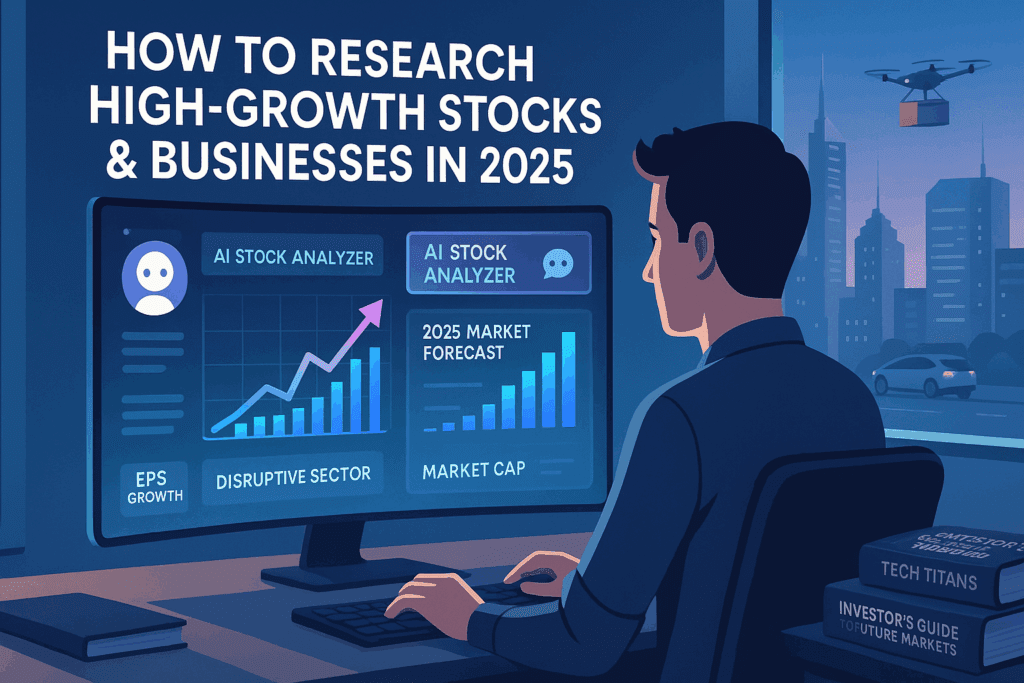Introduction to High-Growth Stock Research
Identifying companies with exceptional growth potential can dramatically improve your investment returns, but finding these market outperformers requires a systematic approach to research and analysis. High-growth stocks can deliver returns that significantly outpace market averages, making them attractive additions to a well-balanced portfolio. In this comprehensive guide, we’ll walk through proven methods to research high-growth stocks in today’s rapidly evolving market landscape.
High-growth stocks are companies expected to increase their revenue and earnings at a significantly faster rate than the overall market or industry average. To research them effectively, analyze financial statements, evaluate competitive advantages, assess management quality, study industry trends, and use stock screening tools to identify candidates with strong growth metrics.
Whether you’re a beginning investor or looking to refine your stock selection process, this guide will equip you with practical strategies to identify promising growth opportunities before they become mainstream. Let’s explore how to find tomorrow’s market leaders today.
What Are High-Growth Stocks?
High-growth stocks represent companies that are expanding their revenue, earnings, and often market share at an accelerated pace compared to industry peers or the broader market. These companies typically reinvest profits back into the business rather than paying dividends, focusing instead on innovation, market expansion, and scaling operations.
Key characteristics of high-growth stocks include:
- Revenue growth rates significantly above industry averages (often 15-30%+ annually)
- Expanding market share in large addressable markets
- Innovative products or services with competitive advantages
- Increasing profit margins or clear path to profitability
- Often trade at higher valuation multiples reflecting future growth expectations
Examples of high-growth sectors in 2025 include:
- Artificial intelligence and machine learning
- Clean energy and sustainability technologies
- Biotech and precision medicine
- Cybersecurity
- Cloud computing and enterprise software
- Digital payments and fintech
- Electric vehicles and autonomous transportation
While high-growth stocks offer tremendous upside potential, they often come with higher volatility and risk. Therefore, thorough research is essential before making investment decisions.
Fundamental Analysis for Growth Stocks: Key Metrics to Evaluate
Fundamental analysis forms the foundation of effective high-growth stock research. Unlike value investing, where investors focus primarily on current valuations relative to assets or earnings, growth investing emphasizes future potential and expansion rates.
Revenue Growth Metrics
The most important indicator for growth stocks is consistent, strong revenue growth. When analyzing a company’s sales performance:
- Year-over-year growth rate: Look for companies maintaining 20%+ annual growth
- Quarter-over-quarter growth: Ensure growth isn’t slowing dramatically
- Revenue acceleration: Particularly promising when growth rates increase over time
- Growth consistency: Steady growth is often preferable to erratic performance
- Organic vs. acquisition-based growth: Organic growth typically signals stronger fundamentals
Always compare a company’s growth rates against industry peers and sector averages to identify true outperformers.
Profitability and Cash Flow Analysis
While many high-growth companies prioritize expansion over immediate profitability, understanding their financial health remains critical:
- Gross profit margins: Should be stable or expanding as the company scales
- Operating margins: Look for improvement over time as the business matures
- Path to profitability: For pre-profit companies, assess management’s timeline and strategy
- Cash burn rate: Calculate how long the company can sustain operations at current spending levels
- Free cash flow growth: Eventually, successful growth companies generate increasing cash flows
For earlier-stage growth companies, focus on unit economics, customer acquisition costs, and lifetime value metrics rather than just bottom-line profitability.
Valuation Considerations for Growth Stocks
High-growth stocks typically trade at premium valuations, making traditional metrics like P/E ratios less useful. Instead, consider:
| Valuation Metric | What It Measures | Target Ranges |
|---|---|---|
| PEG Ratio | Price/Earnings relative to growth rate | Below 1.5 is often considered attractive |
| EV/Sales | Enterprise value relative to revenue | Varies by industry, but lower is better |
| EV/Revenue Growth | Valuation relative to growth rate | Lower indicates better value for growth |
| Rule of 40 | Growth rate + profit margin | Above 40% suggests balanced growth |
| SaaS Magic Number | Revenue gained per dollar of sales spending | Above 0.75 indicates efficient growth |
Remember that appropriate valuations vary significantly by industry and growth stage. What’s expensive for a mature company might be reasonable for a hypergrowth enterprise with massive market potential.
Best Indicators for High-Growth Companies
Beyond standard financial metrics, several qualitative and quantitative indicators help identify companies with superior growth prospects.
Competitive Advantage Assessment
Long-term winners possess sustainable competitive advantages that protect their growth:
- Network effects: Value increases as more users join (e.g., social platforms)
- Switching costs: Difficulty or expense for customers to change providers
- Intellectual property: Patents, proprietary technology, or specialized expertise
- Brand strength: Premium pricing power and customer loyalty
- Scale advantages: Cost benefits from size or market dominance
The strongest growth companies often combine multiple competitive advantages, creating a virtuous cycle that accelerates their market position.
Total Addressable Market (TAM) Analysis
A company can only grow as large as its potential market allows. Evaluate:
- Market size: Is the total addressable market measured in billions or trillions?
- Penetration rate: What percentage of the market has the company captured so far?
- Market growth rate: Is the overall market expanding, providing additional tailwinds?
- Market consolidation: Is the industry fragmented with opportunity for a leader to emerge?
- Adjacent market expansion: Can the company leverage its core strengths to enter related markets?
Companies with small market shares in massive, growing markets often have the most runway for continued expansion.
Management Quality Indicators
Leadership quality is perhaps the most underrated factor in identifying future market winners:
- Track record: Has the management team previously built successful businesses?
- Ownership stake: Do executives have meaningful skin in the game?
- Capital allocation history: How wisely has management deployed resources?
- Innovation culture: Does the company consistently develop new products or enter new markets?
- Transparency: Is management forthright about challenges and realistic about opportunities?
Study earnings call transcripts, interviews, and shareholder letters to assess management’s strategic vision and execution capabilities.
Top Stock Research Tools and Resources for 2025
Modern investors have access to powerful research tools that were once available only to professionals. Here are the most valuable resources for researching high-growth stocks:
Financial Data Platforms
- Yahoo Finance: Comprehensive free resource for financial statements, analyst estimates, and historical data
- Finviz: Excellent free stock screener with visualization tools
- Seeking Alpha: Combines financial data with crowdsourced analysis
- Koyfin: Professional-grade charting and financial data with generous free tier
- TIKR Terminal: Extensive historical financial data and screening capabilities
Premium Research Services
- Morningstar Premium: In-depth analyst reports and fair value estimates
- Simply Wall St: Visual representations of company fundamentals and growth metrics
- YCharts: Institutional-quality data and customized screening
- MarketSmith: Technical and fundamental analysis tools with pattern recognition
- Atom Finance: Curated financial information and document search capabilities
SEC Filing Analysis
SEC filings contain the most reliable company information. Focus on:
- 10-K Annual Reports: Comprehensive overview of business operations, risks, and financial position
- 10-Q Quarterly Reports: More frequent updates on company performance
- 8-K Current Reports: Material events and changes
- S-1 Registration Statements: Detailed information for newly public companies
- Form 4: Insider buying and selling activity
Tools like SEC.gov EDGAR search or BamSEC help navigate these documents efficiently.
Step-by-Step High-Growth Stock Research Process
Follow this systematic approach to identify potential high-growth investment opportunities:
1. Create a Stock Screening System
Start by filtering the universe of stocks using quantitative criteria:
- Revenue growth rate > 20% year-over-year
- Gross margins > 40%
- Return on invested capital > 15%
- Reasonable debt levels for the industry
- Insider ownership > 10%
- Increasing institutional ownership
Adjust these parameters based on your risk tolerance and investment goals.
2. Conduct Thorough Business Analysis
For companies passing your initial screen:
- Study the business model and how the company makes money
- Identify key revenue drivers and growth catalysts
- Analyze competitive positioning within the industry
- Evaluate pricing power and customer concentration
- Assess recurring revenue percentages and customer retention rates
- Research the company’s innovation pipeline and R&D productivity
This qualitative assessment helps separate truly exceptional businesses from temporary high-flyers.
3. Analyze Financial Health and Growth Trajectory
Dig deeper into the financial statements:
- Look for accelerating revenue growth over multiple quarters
- Verify improving gross and operating margins
- Check for sustainable cash flow generation or clear path to positive cash flow
- Evaluate balance sheet strength and capital requirements
- Analyze customer acquisition costs relative to lifetime value
- Review salesforce productivity and efficiency metrics
Be wary of companies showing deteriorating unit economics despite top-line growth.
4. Evaluate Management and Corporate Governance
Assess the leadership team’s:
- Strategic vision and execution capabilities
- Capital allocation history and priorities
- Transparency in communications with shareholders
- Compensation structure and incentive alignment
- Insider purchase activity (suggesting confidence)
- Board quality and independence
The best growth companies are led by visionary yet disciplined management teams.
5. Determine Fair Valuation and Growth Expectations
Finally, assess whether the current stock price reasonably reflects future growth potential:
- Compare valuation multiples to historical ranges
- Calculate implied growth rates based on current valuation
- Perform discounted cash flow analysis with conservative assumptions
- Consider different growth scenarios and their likelihood
- Assess market expectations versus realistic outcomes
- Determine your margin of safety based on confidence level
Remember that even the best company can be a poor investment if purchased at too high a price.
Common Mistakes to Avoid When Researching Growth Stocks
Even experienced investors make these errors when hunting for high-growth opportunities:
Overemphasizing Recent Results
One or two quarters of strong performance doesn’t establish a growth trend. Look for:
- Consistent growth over multiple years
- Performance across different economic conditions
- Growth relative to increasing revenue base (harder as companies scale)
Ignoring Cash Flow and Balance Sheet
Revenue growth alone doesn’t create shareholder value. Always examine:
- Cash flow from operations trends
- Capital expenditure requirements
- Debt levels and interest coverage
- Share dilution through stock-based compensation
Overlooking Competitive Threats
Today’s growth leader can quickly become tomorrow’s laggard. Consider:
- Barriers to entry in the industry
- Emerging technologies that could disrupt the business
- Larger competitors with more resources
- Regulatory risks specific to the sector
Falling for Narrative Without Substance
Compelling stories can mask fundamental business weaknesses. Verify:
- That management claims match financial reality
- Market size estimates are realistic
- Growth initiatives are gaining traction
- Key performance indicators beyond headline numbers
Paying Too Much for Growth
Overpaying negates even exceptional business performance. Be disciplined about:
- Setting valuation limits based on realistic growth scenarios
- Requiring higher margin of safety for less predictable businesses
- Walking away when prices exceed reasonable growth expectations
- Being patient for better entry points during market volatility
Industry-Specific Growth Analysis: What to Look For
Different sectors require specialized analysis approaches:
Software and Technology
Key metrics to analyze:
- Annual recurring revenue (ARR) growth
- Net revenue retention rate (above 120% is excellent)
- Customer acquisition cost (CAC) and payback period
- Gross margin and path to operating leverage
- R&D productivity and product development cadence
Healthcare and Biotech
Focus areas:
- Clinical trial pipeline and stage of development
- Addressable patient population and pricing power
- Regulatory approval timeline and risks
- Patent protection duration and strength
- Reimbursement landscape and payer dynamics
Consumer Products and Retail
Evaluate:
- Same-store sales growth
- Customer acquisition costs and lifetime value
- Brand strength and pricing power
- Omnichannel capabilities
- Supply chain efficiency and inventory management
Financial Services
Consider:
- Assets under management growth
- Net interest margin trends
- Credit quality metrics
- Technology integration and digital capabilities
- Customer acquisition efficiency
By tailoring your analysis to industry-specific value drivers, you’ll better identify true growth opportunities.
Building a High-Growth Stock Watchlist
Rather than rushing into investments, create a watchlist of promising candidates:
- Set clear criteria for companies that match your investment philosophy
- Track performance over multiple quarters to confirm sustainable growth
- Establish price targets based on reasonable valuation metrics
- Create alerts for significant developments or price movements
- Document investment thesis for each watchlist company
This disciplined approach helps you build conviction while waiting for attractive entry points.
Conclusion: Becoming a Better Growth Stock Investor
Researching high-growth stocks is both art and science, requiring quantitative analysis, qualitative assessment, and disciplined decision-making. By following the framework outlined in this guide, you’ll develop a systematic approach to identifying companies with exceptional growth potential before the broader market recognizes their value.
Remember that even the most thorough research can’t eliminate all investment risk. Maintain a diversified portfolio, position size appropriately based on conviction and risk, and be prepared to adjust your thesis as new information emerges.
The most successful growth investors combine rigorous analysis with continuous learning. Start applying these research techniques today, refine your process over time, and you’ll be well-positioned to identify the market leaders of tomorrow.
Ready to put these research methods into practice? Begin by screening for high-growth candidates using the metrics we’ve discussed, then perform your detailed analysis using the step-by-step framework. Your journey to becoming a more effective growth investor starts now.
Want to improve your investment knowledge? Check out our related guides:
- Beginner’s Guide to Stock Market Investing
- How to Build a Balanced Investment Portfolio
- Understanding Stock Valuation Methods
- Technical Analysis for Long-Term Investors






Your positive and uplifting words are like a ray of sunshine on a cloudy day Thank you for spreading light and positivity in the world
I can’t get enough of your insightful articles and engaging stories. Thank you for sharing your passion with the world!